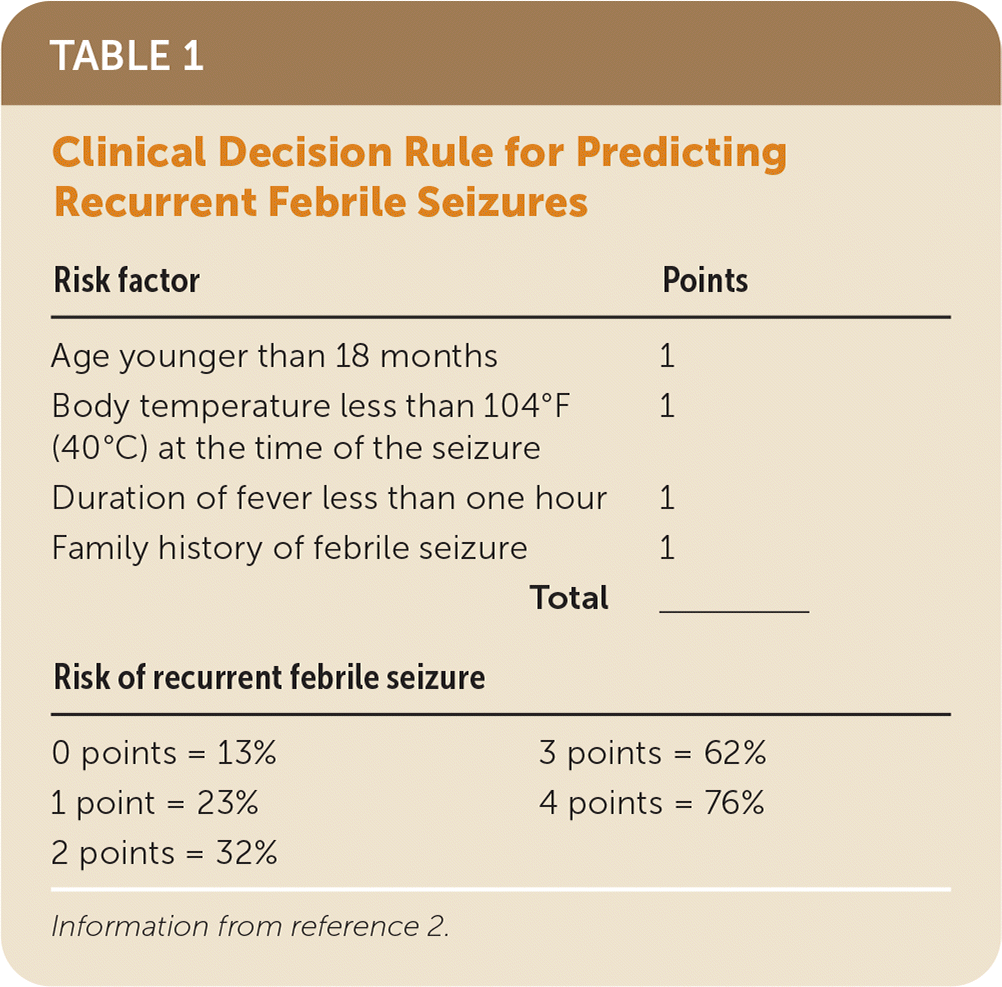
Am Fam Physician. 2020;101(8):497-478
Author disclosure: No relevant financial affiliations.
Clinical Question
In children presenting with a simple febrile seizure, is it possible to determine the likelihood of a recurrent febrile seizure?
Evidence Summary
Febrile seizures occur in children with fever who do not have a history of epilepsy or central nervous system infection.1 Febrile seizures are classified as simple (generalized, lasts less than 15 minutes, and occurs once in 24 hours) or complex (focal, lasts longer than 15 minutes, or recurs within 24 hours). They affect 2% to 5% of children six months to five years of age and can be associated with almost any infectious etiology.1
Although febrile seizures are usually benign and self-limited, up to one-third of patients will have a recurrence.1 Being able to predict the likelihood of recurrent seizures would be helpful in addressing parents' concerns about their child having another seizure and assist physicians in counseling parents on the appropriate aftercare.
In the 1980s and 1990s, a cohort of young children who had febrile seizures were followed for recurrent seizures.2 Multiple potential predictors of recurrence were noted: the patient's temperature when the seizure occurred, duration of fever prior to the seizure, patient age, family history of febrile seizures, family history of epilepsy, presence of a neurodevelopmental abnormality, patient sex, patient race, type of seizure (simple or complex), and duration of seizure. In a multivariate analysis, the investigators found that younger age, family history of febrile seizures, shorter duration of fever, and lower temperature were all independently associated with an increased likelihood of recurrent seizure. From this, Berg and colleagues constructed a four-variable clinical decision rule to predict the likelihood of seizure recurrence (Table 1).2

| Risk factor | Points |
|---|---|
| Age younger than 18 months | 1 |
| Body temperature less than 104°F (40°C) at the time of the seizure | 1 |
| Duration of fever less than one hour | 1 |
| Family history of febrile seizure | 1 |
| Total | ______ |
| Risk of recurrent febrile seizure | |
|
Overall, the risk of a recurrence after febrile seizure is 32%. Most patients who have a recurrence will have only one additional episode (54%), although 28% will have two recurrences and 18% will have three or more recurrences. Among those having recurrent seizures, 75% will have them within one year.2
Studies conducted in other countries have also found predictors of recurrent febrile seizures. A Greek study showed that younger age at the time of the seizure, complex febrile seizure, and family history of febrile seizures predicted recurrence.3 A Turkish study found that recurrent febrile seizures are more common among children living in nonurban housing, children with a family income above the subsistence level, and children with a family history of febrile seizures.4 An Indian study found that younger age at the time of the seizure, lower body temperature, family history of febrile seizures, and brief duration between fever onset and seizure were predictive of recurrence.5 An Italian study found that abnormal electroencephalogram findings during hospitalization for a febrile seizure predicted future recurrence.6
Among these studies, family history of febrile seizures in the Greek, Turkish, and Indian studies; younger age at onset in the Greek and Indian studies; and lower temperature and brief duration between fever onset and seizure in the Indian study were similar to the predictors found in the U.S. study. Although the Berg rule has not been prospectively validated, the consistency of the predictors in this rule with those in other studies and populations is reassuring.
The American Academy of Pediatrics has produced a clinical practice guideline for the management of neurodevelopmentally normal patients six months to five years of age with simple febrile seizures. Routine use of lumbar puncture, laboratory assays, neuroimaging, and electroencephalography is not recommended in the evaluation of simple febrile seizures. The guidelines recommend that lumbar puncture be obtained if meningitis or intracranial infection is suspected. Lumbar puncture should be considered in infants six to 12 months of age who are behind in receiving Haemophilus influenzae type b or pneumococcal immunizations or in children who have been pretreated with antibiotics (because treatment can mask indicators of meningitis). The guideline also affirms that although simple febrile seizures are associated with a slightly increased risk of epilepsy, there is no association with mortality or mental retardation.7 Management of patients with complex febrile seizures is not in the scope of the guideline, although the literature suggests that these children may benefit from neuroimaging and electroencephalography but not routine lumbar puncture.1
Applying the Evidence
A two-year-old girl presents to your family medicine clinic 30 minutes after having a generalized seizure. She had a fever of 102.2°F (39°C) for 30 minutes prior to the seizure, which lasted five minutes. She has no family history of febrile seizures and is up to date on all age-appropriate health care, including immunizations. Her examination findings are normal.
Per the American Academy of Pediatrics clinical practice guideline, the patient needs no other diagnostic workup.7 You counsel the parents that she has two out of four predictors of recurrent febrile seizure (Table 1), giving her about a one in three chance of having another febrile seizure in the future.2
Editor's Note: Dr. Saguil is a contributing editor for AFP.
The views expressed in this article are the authors' and do not reflect the official policy or position of the Uniformed Services University of the Health Sciences, the Department of Defense, or the U.S. government.
